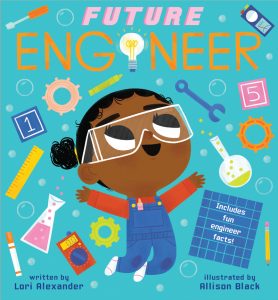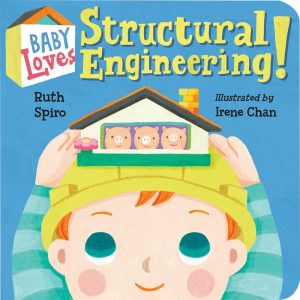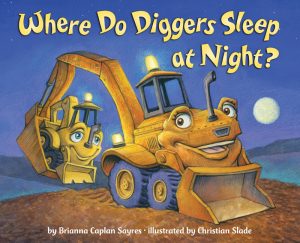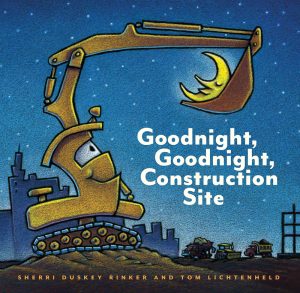A Review of Some Interesting Titles
Goodnight Moon (HarperCollins). Chica Chica Boom Boom (Little Simon). The Very Hungry Caterpillar (World of Eric Carle). Great classics of children’s literature written for the youngest babies and gifted to new parents regularly. But how about Future Engineer or Baby Loves Structural Engineering? Also excellent books, written for the youngest babies, but not nearly as well known and primarily gifted to or from an engineer. These deserve a place on every young reader’s shelf, not just those with a direct connection to the field of engineering.
You might be wondering how this relates to the mission of STRUCTURE magazine. We strive to “engage, enlighten, and empower structural engineers.” This includes contributing to and encouraging the expansion of the profession and engaging non-traditional populations, such as babies. Just as many of our editorial board members are parents with small children, so are many of our readers; and if you are not, you likely know someone who is.
When speaking to students, especially at the high school or early college level, it is common to hear, “I don’t know what an engineer is/does.” We may be missing out on some of the best talent simply because the students do not know the possibilities of engineering, and therefore do not pursue the field. Unless they have a family member working in engineering, or an unusually good high school guidance counselor, they are likely never introduced to it. Education and outreach at the high school level are clearly very important to combat this issue. However, engineering books introduced to babies can have a positive impact as well. Just knowing what an engineer is, even at the most basic level, might be all the push a student needs to investigate further. This obviously takes the long view, but we suspect it is easier to tackle the issue by getting to the young in their formative years rather than trying for a mid-course correction or a turn at the last moment.

Future Engineer by Lori Alexander (Cartwheel Books) introduces the concept of an Engineer by drawing parallels to babies’ natural interests, making the field approachable to anyone.
This simple board book features brightly colored paired cartoon drawings of the Engineer working and Baby doing something similar in their own way. A full range of diverse characters, both for the Engineer and for Baby, keep this book current and allow almost any child to recognize themselves within the pages. The story remains neutral to all types of engineering, but the last page does have simple descriptions of six common engineering fields.

Baby Loves Structural Engineering by Ruth Spiro (Charlesbridge) takes a narrower approach, focusing solely on structural engineering, specifically building a house. It appeals to the natural curiosity and basic block-building interests of many babies.
The story follows Baby as they build a house with blocks and uses slightly more technical language than other books. Throughout the story, baby remains a single character, never given an assigned gender, allowing the focus to remain on the building. The house has a foundation that must hold up the walls and all the loads inside; walls must hold up the roof and help stay strong no matter the weather, and a roof keeps everyone safe and dry. It even goes so far as to label the structure as dead load and the cartoon pigs living inside the house as live load. This early introduction of the language of engineering is valuable in making the field approachable as the child grows. When the language and simple concepts are familiar, even in a basic sense, the “scary” factor of an unknown field is greatly diminished.
Possibly more mainstream are children’s books focused on trucks and construction equipment. While not as directly about engineering, these stories still spark interest in how things are built and the construction activities children see around them, opening the opportunity for further conversation. For example, a kid getting excited about seeing an excavator or crane on the side of the road may someday be the construction engineer directing them.

Where Do Diggers Sleep at Night? by Brianna Caplan Sayres (Random House Books for Young Readers) is a simple rhyming bedtime book introducing different types of trucks and construction equipment.
The characters here are the trucks; young trucks are presented gender neutral with an almost even split of mom and dad trucks putting them to bed. Each rhyme gives some information about the purpose of the subject truck but does not get technical, and the focus remains on bedtime. This book does a good job of mixing in less common construction vehicles with trucks that children may be more familiar with, like the garbage truck, helping broaden horizons and interests.

Goodnight, Goodnight, Construction Site by Sherri Duskey Rinker and Tom Lichtenheld (Chronicle Books) tells the story of five truck friends as they finish up their site work for the day and go to bed. The rhymes here are slightly longer and include far more details about the purpose and parts of each truck and its role on the construction site.
The focus here is again on construction rather than engineering design or problem-solving. The story provides an opportunity to learn about the individual trucks and discuss how they work together, and the book is written more at a toddler or older toddler level than the others. A series of books have followed, including Mighty, Mighty Construction Site, Three Cheers for Kid McGear!, and Construction Site Mission: Demolition, which expands on the idea of job site teamwork and introduces more trucks to the crew, including a much needed female truck, as the first book, unfortunately, presents all five trucks as male. As a series, the concepts presented give a nice overview of the complex construction field and equipment at an age-appropriate level, potentially sparking future interest.
With so many children’s books available, it is easy to write off ones about engineering as “niche” or “gag gifts,” assuming they will only appeal to parents already working in the profession. Remember that these books are written for children and not just those whose mom, dad, aunt, or uncle are already exposing them to engineering. Kids are listening and learning about the world and opportunities through books. Let’s present them all with the opportunity to learn about engineering while they are young so that it is not new or scary when they are older.
Next month, we will discuss books written for preschool and early elementary-aged future engineers. These focus more on the problem solving, teamwork, and design process involved in engineering. The gender split also plays a more prominent role in these books as well.■
